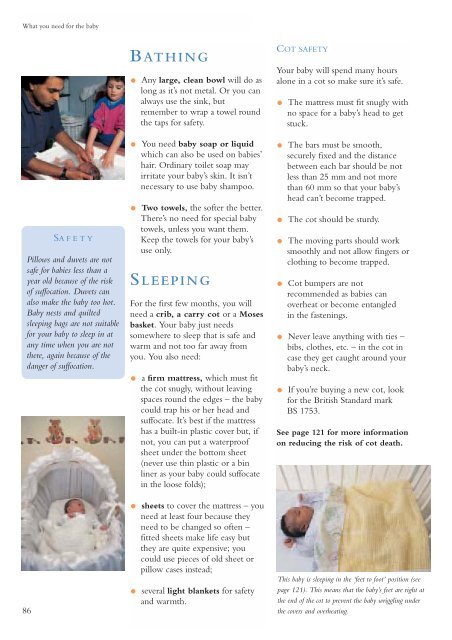here - Health Promotion Agency
here - Health Promotion Agency
here - Health Promotion Agency
You also want an ePaper? Increase the reach of your titles
YUMPU automatically turns print PDFs into web optimized ePapers that Google loves.
What you need for the baby<br />
SA FETY<br />
Pillows and duvets are not<br />
safe for babies less than a<br />
year old because of the risk<br />
of suffocation. Duvets can<br />
also make the baby too hot.<br />
Baby nests and quilted<br />
sleeping bags are not suitable<br />
for your baby to sleep in at<br />
any time when you are not<br />
t<strong>here</strong>, again because of the<br />
danger of suffocation.<br />
86<br />
BATHING<br />
•<br />
Any large, clean bowl will do as<br />
long as it’s not metal. Or you can<br />
always use the sink, but<br />
remember to wrap a towel round<br />
the taps for safety.<br />
• You need baby soap or liquid<br />
which can also be used on babies’<br />
hair. Ordinary toilet soap may<br />
irritate your baby’s skin. It isn’t<br />
necessary to use baby shampoo.<br />
•<br />
Two towels, the softer the better.<br />
T<strong>here</strong>’s no need for special baby<br />
towels, unless you want them.<br />
Keep the towels for your baby’s<br />
use only.<br />
S LEEPING<br />
For the first few months, you will<br />
need a crib, a carry cot or a Moses<br />
basket. Your baby just needs<br />
somew<strong>here</strong> to sleep that is safe and<br />
warm and not too far away from<br />
you. You also need:<br />
• a firm mattress, which must fit<br />
the cot snugly, without leaving<br />
spaces round the edges – the baby<br />
could trap his or her head and<br />
suffocate. It’s best if the mattress<br />
has a built-in plastic cover but, if<br />
not, you can put a waterproof<br />
sheet under the bottom sheet<br />
(never use thin plastic or a bin<br />
liner as your baby could suffocate<br />
in the loose folds);<br />
•<br />
sheets to cover the mattress – you<br />
need at least four because they<br />
need to be changed so often –<br />
fitted sheets make life easy but<br />
they are quite expensive; you<br />
could use pieces of old sheet or<br />
pillow cases instead;<br />
• several light blankets for safety<br />
and warmth.<br />
COT SAFETY<br />
Your baby will spend many hours<br />
alone in a cot so make sure it’s safe.<br />
• The mattress must fit snugly with<br />
no space for a baby’s head to get<br />
stuck.<br />
•<br />
The bars must be smooth,<br />
securely fixed and the distance<br />
between each bar should be not<br />
less than 25 mm and not more<br />
than 60 mm so that your baby’s<br />
head can’t become trapped.<br />
• The cot should be sturdy.<br />
•<br />
The moving parts should work<br />
smoothly and not allow fingers or<br />
clothing to become trapped.<br />
• Cot bumpers are not<br />
recommended as babies can<br />
overheat or become entangled<br />
in the fastenings.<br />
•<br />
Never leave anything with ties –<br />
bibs, clothes, etc. – in the cot in<br />
case they get caught around your<br />
baby’s neck.<br />
• If you’re buying a new cot, look<br />
for the British Standard mark<br />
BS 1753.<br />
See page 121 for more information<br />
on reducing the risk of cot death.<br />
This baby is sleeping in the ‘feet to foot’ position (see<br />
page 121). This means that the baby’s feet are right at<br />
the end of the cot to prevent the baby wriggling under<br />
the covers and overheating.
















